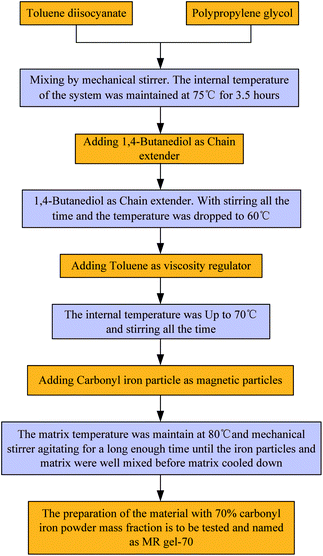 Open Access Article
Open Access ArticleExperimental investigation on the influence of temperature on the hysteresis behavior of magnetorheological gel by employing a large-amplitude-oscillation-shear test method
Chen Wei
Hebei Chemical & Pharmaceutical College, Shijiazhuang, 050200, China. E-mail: yayun1234@126.com
First published on 18th January 2022
Abstract
It is of great significance to explore the mechanism of temperature influence on magnetorheological gel before employing materials for device design. Because of the temperature of the materials rising by the coil during the working process, the wall sliding effect, the interaction between the particles and the interaction between the particles and the polymer chain occur inevitably, which further affects the mechanical properties of the material. This study investigated the effect of temperature on magnetorheological hysteresis properties and its mechanism by employing a large-amplitude-oscillation-shear test method at different temperatures (i.e., 10 °C, 30 °C, 50 °C, 70 °C, 90 °C). The temperature behavior of the MR gel-70 is experimentally evaluated under various loading conditions, including five levels of current inputs of 0 A, 0.5 A, 1 A, 2 A and 4 A, and three excitation frequencies of 5 Hz, 10 Hz and 15 Hz, respectively. The microstructure and the magnetic performance of the sample are probed by employing a scanning electron microscope and vibrating sample magnetometer. It is indicated from the result that magnetorheological gel as a magnetized-induced material and its mechanical properties are greatly influenced by temperature, current and frequency.
1. Introduction
Magnetorheological (MR) gel is a novel type of MR material, and is a composite fluid in which micro or sub-nanometer ferromagnetic particles are suspended in a polymer gel matrix.1–3 Without the effect of a magnetic field, the MR gel behaves as a gel-like state. After applying a magnetic field, the MR gel, however, is able to convert between a gel-like status and semi-solid state in a continuous and reversible manner. Due to controllable viscoelastic and damping properties, MR gel has exhibited highly excellent potential in the design of semi-active smart devices such as a damper, clutch, brake, etc.4–7For the MR power transmission apparatus (i.e., damper, clutch and brake etc.), the temperature of rising of the materials due to the coil during the working process will cause the wall sliding effect, the interaction between the particles and the interaction between the particles and the polymer chain. With the increase of the temperature of the device, the MR behaviors of MR gel are implicated and the controllable performance will be harmed accordingly.8–12 Therefore, many researchers have carried out a series of related studies focusing on the influence of temperature on MR materials, which contributed remarkable outcomes. Li et al.13 investigated the influence of temperature on MR behaviors and constructed a new constitutive model for predicting the MR performance in a wide temperature range. The results indicate that the Herschel–Bulkley model can not describe the MR properties accurately, especially when the temperature is higher than 70 °C. The proposed novel constitutive, however, exhibits excellent accuracy. Zhang et al.14 evaluated the temperature stability and durability of the MR fluid. The results show that the temperature has a great impact on the stability and durability of prepared MR fluid. Tian et al.15 obtained the influence mechanism of temperature on the torque transmission stability of MR fluid and the analysis results indicated that compared with rotational speed, temperature is the main factor affecting the torque fluctuation of magnetorheological fluid. Mckee et al.16 investigated the temperature effect on characteristics (i.e., bulk modulus, shear yield stress and viscosity) of self-prepared MR fluid. It was found that both the stiffness and the energy dissipation properties decrease with an increase in the temperature of MR fluid.
In addition to the temperature characteristics of MR fluid, and the temperature-relatived rheological phenomenon of other MR materials, such as MR elastomers and MR grease, have been studied. Agirre et al.17 studied the linear viscoelastic properties of MR elastomers under different magnetic fields and temperatures by adopting strain and frequency sweep using MRC 501. The results described that high temperature restricts the linear viscoelastic behavior of MR elastomer. Wang et al.18 investigated the impact of temperature on the rheological properties of MR grease with 70 wt% of carbonyl iron, and the results demonstrate that the increase of temperature leads to the increase of storage modulus and the reduction of the loss factor.
As a novel type of smart MR material, MR gel has been investigated by the researchers in terms of rheological properties because of ideal controllable performance.19 Zhang et al.20 studied the dynamic behaviors of MR gel with the various weight of carbonyl-iron-particle employing large-amplitude oscillation shearing measurement. The results described that the onset strain value from the linear region to the nonlinear viscoelastic area increases along with the weight of carbonyl-iron-particle. Kim et al.21 investigated the effects of multiwall carbon nanotubes on dynamic stiffness of hydrophilic-base MR gel. Zhang et al.22 systemically analyzed the impact of carbonyl-iron-particle content on the field-dependent dynamic viscoelastic properties of MR gels. However, the recent research of the MR gel is mainly focused on the impact of carbonyl-iron-particle content and additive on dynamic behaviors. Few studies have been reported on the effect of the temperature on MR gel and its mechanism.
Based on the above discussion, this work firstly develops the MR gel with 70% carbonyl-iron-particle mass fraction. Since the magnetic shear stress change of the MR gel with 70% carbonyl-iron-particle mass fraction is the most obvious, and the magnetorheological effect is the best.23 Then, the large-amplitude-oscillation-shear test method is employed to obtain the hysteresis characteristic curve of the material at different temperature conditions. Finally, the influence of temperature on the hysteresis characteristic of the material and its mechanism is systemically analyzed.
2. Specimen development and experimental test
2.1 Preparation of MR gel
Six types of raw materials are employed to prepare MR gel, i.e., two main reactants (toluene diisocyanate and polypropylene glycol), chain extender (1,4-butanediol), catalyst (dibutyltin dilaurate), viscosity regulator (toluene) and carbonyl iron particle (magnetic material). The detailed information of raw materials is shown in Table 1.| Raw materials | Type | Producer |
|---|---|---|
| Toluene diisocyanate | TDI; 2,4-≈79%, 2,6-≈21% | Hubei Keward Chemical Co., Ltd, China |
| Polypropylene glycol | PPG-1800 | Haian Petrochemical Plant in Jiangsu Province, China |
| 1,4-Butanediol | BDO | Shandong Xinheng Chemical Co., Ltd, China |
| Dibutyltin dilaurate | DBTDL | Hubei Keward Chemical Co., Ltd, China |
| Toluene | — | Lianyungang Taylor Chemical Industry Co., Ltd, China |
| Carbonyl iron particle | CIP-CN with particle size of about 3–10 μm | Produced by BASF, Germany |
The process of preparing MR gel with 70% carbonyl iron particle weight content is described in Fig. 1. The basic matrix has a significant effect on the rheological performances of MR gel. In this study, polyurethane is adopted as basic carrier due to the fact that their physical and mechanical performance can be adjusted by controlling the content of raw materials, therefore meeting the different requirements of engineering. In the development of MR gel, toluene diisocyanate with 2,4-≈79%, 2,6-≈21% and polypropylene glycol with PPG-1800 are employed.
2.2 Characteristics measurement
A scanning electron microscope (SEM) is used to examine whether the carbonyl iron power dispersed in the polyurethane matrix evenly, which is modeled Quant 250FEG. A vibrating sample magnetometer (VSM) is employed to probe the magnetic performance of the prepared MR gel-70. The hysteresis loops of MR gel in various test conditions are obtained by using rotational rheometer modeled MCR Physica 302 made from Anton Paar. In this work, large-amplitude-oscillation-shear test method is employed to obtain the hysteresis characteristic curve of the material at different temperatures (i.e., 10 °C, 30 °C, 50 °C, 70 °C, 90 °C). Under large-amplitude-oscillation-shear measurement environment, the strain amplitude is keep at 50%, the frequencies range from 5 Hz to 15 Hz with the increment of 5 Hz, and the current levels are 0 A, 0.5 A, 1 A, 2 A and 4 A. To maintain the table test results, the interval between each test point is set to 20 seconds. Furthermore, the experiment test condition was performed three times, and then the average values were calculated to ensure the reproducibility of the obtained data.3. Results and discussion
3.1 Sample characteristics
It is worth noting that the initial state (without current flowing through coils) of MR gel is gel-like, which is shown in Fig. 2a. After the current is applied, MR gel changing from initial gel-like state to solid-like state and shows controllable properties, which is shown in Fig. 2b. The microstructures of the sample (MR gel-70) is explored by employing SEM and the results is shown in Fig. 2c. The off-white ball represents the carbonyl iron particles, and the black background express the polyurethane matrix. It can be indicated from Fig. 2c that the carbonyl iron particles dispersed in the matrix homogeneous, indicating the prepared sample has isotropic properties. Isotropic properties observed from the result shows the surface of carbonyl iron particles have good interfacial bonding with the polyurethane polymer. The magnetic properties of the materials is extremely important characteristic, which reflect the performance of the magneto-mechanical. Therefore, the magnetic characteristic of the sample is measurement by adopted VSM with the magnetic field from −15![[thin space (1/6-em)]](https://www.rsc.org/images/entities/char_2009.gif) 000 Oe to 15
000 Oe to 15![[thin space (1/6-em)]](https://www.rsc.org/images/entities/char_2009.gif) 000 kOe at the room temperature (20 °C), which is shown in Fig. 2d. It is described that the magnetic flux density of the sample increases sharply along with magnetic field ranging from −5000 Oe to 5000 Oe. Further increase magnetic field, the magnetic flux density stable at 1 T. The results discussed above describing that the impact of the magnetic field on the MR gel-70 has obvious regional properties.
000 kOe at the room temperature (20 °C), which is shown in Fig. 2d. It is described that the magnetic flux density of the sample increases sharply along with magnetic field ranging from −5000 Oe to 5000 Oe. Further increase magnetic field, the magnetic flux density stable at 1 T. The results discussed above describing that the impact of the magnetic field on the MR gel-70 has obvious regional properties.
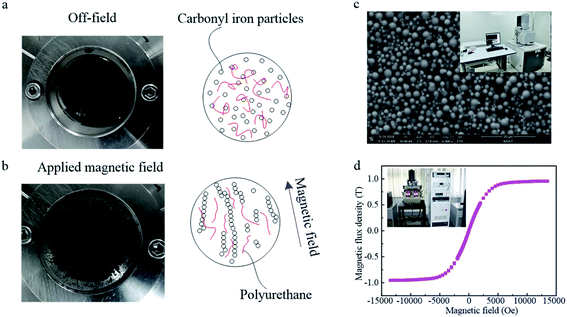 | ||
| Fig. 2 MR gel (a) without magnetic field, (b) under application of the magnetic field, (c) micro-structure and (d) magnetic behaviors of carbonyl iron particles and polyurethane-based MR gel. | ||
3.2 Magnetorheological hysteresis behaviors
The intelligence of MR smart materials is manifested in its controllability. Therefore, to study performance of MR materials, it is necessary to obtain the magneto-controllability of the materials firstly. For the convenience of description, the shear stress mentioned below refers to the strain at 50%.The hysteresis performances of the MR gel-70 suffer various currents (i.e., 0 A, 0.5 A, 1 A, 2 A and 4 A) under different temperatures (i.e., 10 °C, 30 °C, 50 °C, 70 °C and 90 °C) at fixed shear frequency of 10 Hz are shown in Fig. 3. As indicated from the Fig. 3, both the current and the temperature have extremely impact on the shear stress. More detail is that the shear stress decreases continuous along with temperature under all current conditions. For instance, for the fixed current of 4 A, the shear stress of the sample are 25.856 kPa, 17.039 kPa, 14.041 kPa, 11.498 kPa and 9.576 kPa under temperature of 10 °C, 30 °C, 50 °C, 70 °C and 90 °C respectively. It is mainly result from the influence of temperature on polyurethane-based matrix. With increasing of temperature, the viscosity of MR gel reduce rapidly,18 which result in decreasing of shear stress. In addition, the influence regular of the current on the MR gel-70 is affected by applied temperature. Under the temperature of 10 °C, the shear stress of the sample increases along with current. However, for the other four applied temperature situations, shear stress increases along with current first. Further increase current, for example, the current change from 2 A to 4 A, the shear stress decrease instead. This phenomenon may be due to the fact that the polymer inside the polyurethane become more active under higher temperature, especially at current more than 2 A.
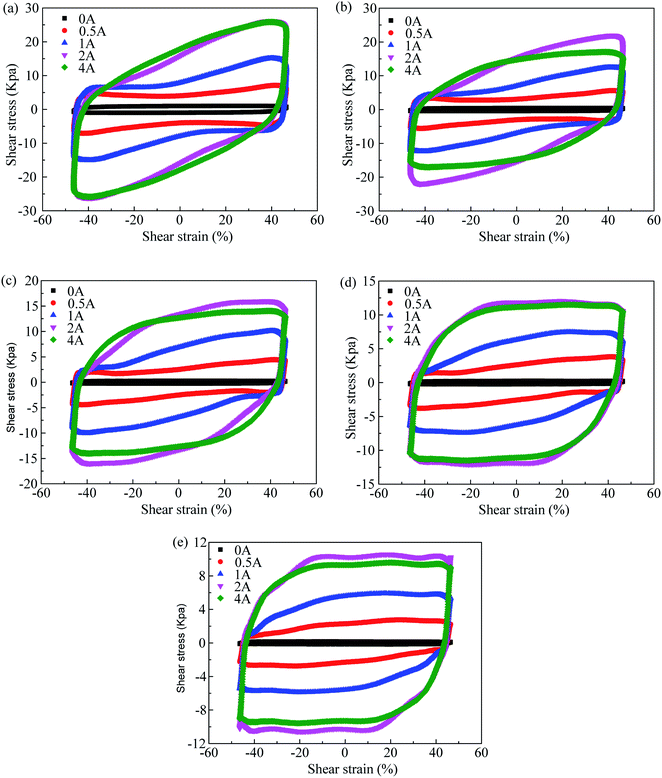 | ||
| Fig. 3 The hysteresis behaviors of the MR gel-70 under various currents at shear frequency of 10 Hz; (a) 10 °C, (b) 30 °C, (c) 50 °C, (d) 70 °C and (e) 90 °C. | ||
The device using MR gel-70 as energy conversion medium experience load excitation of various frequencies inevitably. Therefore, it is great important to explore the hysteresis characteristics of the sample under different loading frequencies.
Fig. 4 describe the hysteresis behaviors of the MR gel-70 under the conditions of various shear frequencies (5 Hz, 10 Hz and 15 Hz) at a fixed current level of 1 A, and five levels of temperatures, i.e., 10 °C, 30 °C, 50 °C, 70 °C and 90 °C. It can be indicated from the Fig. 4 that shear frequency has a significant effect on shear stress, and the shear stress increases stably along with the increase excitation frequency, especially under the temperature of 10 °C and 70 °C. The detail is that the shear stress are 11.529 kPa, 15.083 kPa and 16.788 kPa under 5 Hz, 10 Hz and 15 Hz at temperature of 10 °C respectively. The same phenomenon can be found under different applied current, the shear stress of the sample decreases along with temperature. For instance, when the loading frequency is 15 Hz, the shear stress are 16.788 kPa, 12.478 kPa, 10.774 kPa, 8.328 kPa and 6.348 kPa exploring the temperature of 10 °C, 30 °C, 50 °C, 70 °C and 90 °C, respectively.
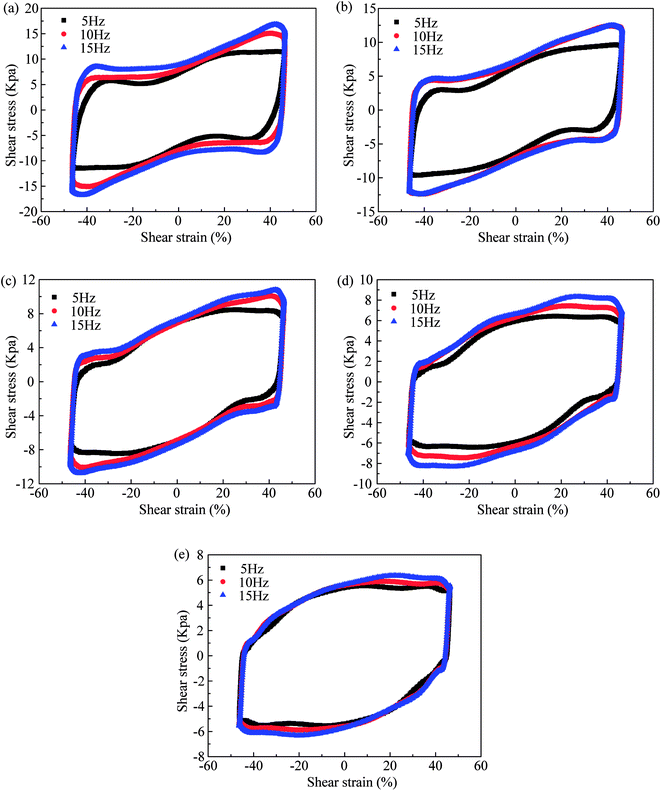 | ||
| Fig. 4 The hysteresis behaviors of the MR gel-70 under various shear frequencies at current of 1 A; (a) 10 °C, (b) 30 °C, (c) 50 °C, (d) 70 °C and (e) 90 °C. | ||
The viscoelasticity of the materials is an important indicator to describe the performance of the MR gel. Viscosity characteristics indicate the ability of energy dissipation, and elasticity describes the ability to store energy. In the stress–strain loops, the viscosity of the materials depends on the area surrounded by the loop, which represents the energy dissipated by the materials in one cycle of shearing. In this work, the elastic properties are defined as the follows: the ratio of the stress and strain, which can be expressed as: (τ50% − τ−50%)/(50% − (−50%)). Where, τ50% and τ−50% are shear stress under shear strain at 50% and −50% respectively.
The hysteresis characteristics of MR gel-70 under the conditions of loading frequencies of 5 Hz, 10 Hz and 15 Hz, five level of temperatures of 10 °C, 30 °C, 50 °C, 70 °C and 90 °C, of currents of (0 A, 0.5 A, 1 A, 2 A and 4 A) are shown in Fig. 5, 6 and 7, respectively. It can be described from Fig. 5, 6 and 7 that for all test situations (i.e., frequencies of 5 Hz, 10 Hz and 15 Hz and currents of 0 A, 0.5 A, 1 A, 2 A and 4 A), the shear stress of the developed MR gel-70 decreases continuous along with temperature. In detail, when the current level is 4 A and loading frequency is 15 Hz, the shear stresses of the sample are 27.379 kPa, 17.869 kPa, 15.075 kPa, 11.562 kPa and 9.109 kPa for different temperatures of 10 °C, 30 °C, 50 °C, 70 °C and 90 °C, respectively. The main reasons for those phenomenon are summarized as follows: (1) the magnetized performance of the carbonyl iron particles decreases along with the increase of temperature; (2) the impact of temperature on interaction between carbonyl iron particles and matrix; (3) the viscosity of matrix decreases along with the increase of temperature.
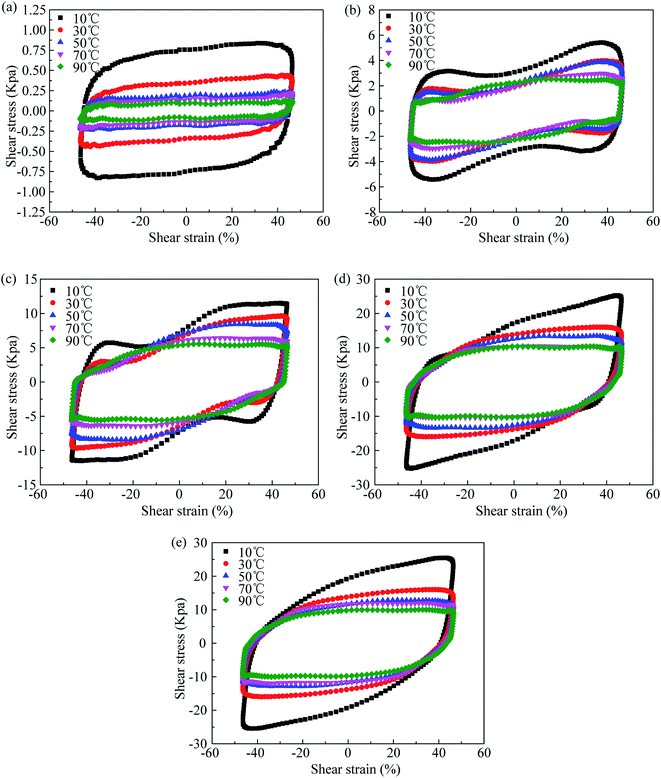 | ||
| Fig. 5 The hysteresis loop of MR gel-70 at fixed frequency of 5 Hz under different temperatures suffering five kinds of currents; (a) 0 A, (b) 0.5 A, (c) 1 A, (d) 2 A and (e) 4 A. | ||
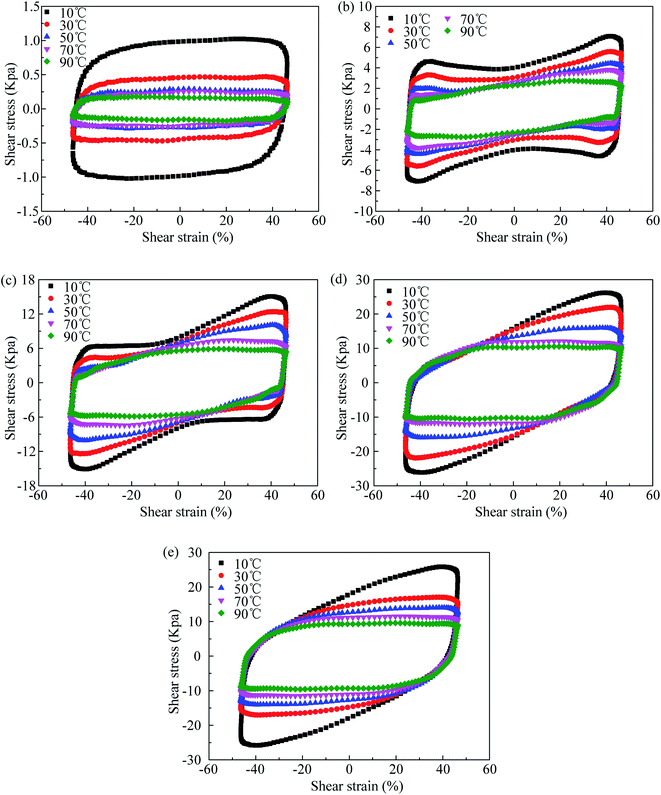 | ||
| Fig. 6 The hysteresis loop of MR gel-70 at fixed frequency of 10 Hz under different temperatures suffering five kinds of currents; (a) 0 A, (b) 0.5 A, (c) 1 A, (d) 2 A and (e) 4 A. | ||
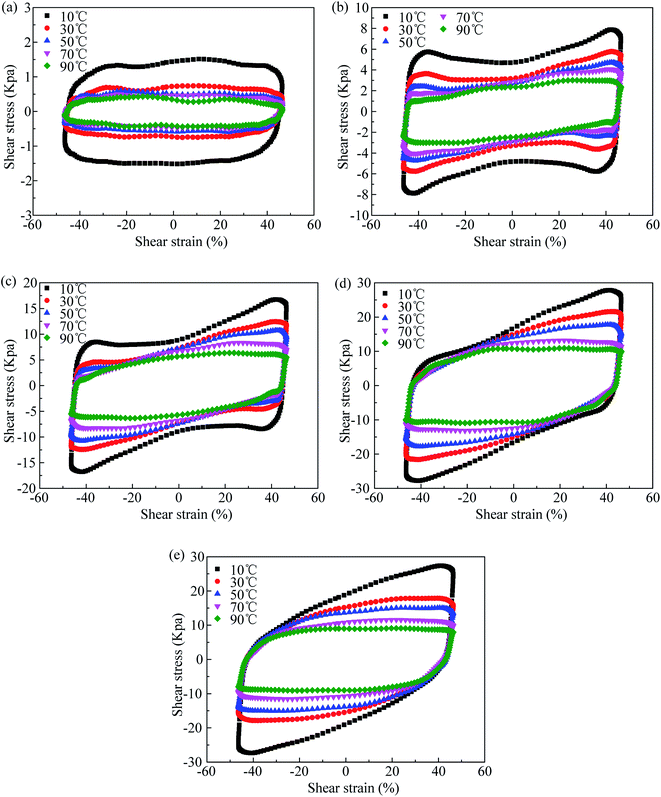 | ||
| Fig. 7 The hysteresis loop of MR gel-70 at fixed frequency of 15 Hz under different temperatures suffering five kinds of currents; (a) 0 A, (b) 0.5 A, (c) 1 A, (d) 2 A and (e) 4 A. | ||
In addition, more important, both the current, frequency and temperature have greatly influency on the viscosity and elasticity characteristics of the sample. More detail described, the viscosity performance become more evident along with current. The reason for this phenomenon is that the magnetic flux density of the sample increases along with magnetic field ranging from −5000 Oe to 5000 Oe, which described in Fig. 2b. The change regular along with excitation frequency is same to current. Conversely, the viscosity behaviors decreases along with applied temperature, which due to the fact that the viscosity of the matrix decreases along with temperature.
The elasticity properties of the sample are listed at Table 2. The elasticity characteristics increase along with applied current and frequency. The reason for this phenomenon is that the magnetic flux density of the sample increases along with magnetic field ranging, which described in Fig. 2b. Otherwise, the elasticity behaviors decreases along with applied temperature, which is due to the fact that the magnetizing ability and viscosity of the matrix decreases along with the temperature.
| Current | 0 A | 0.5 A | 1 A | 2 A | 4 A |
|---|---|---|---|---|---|
| 10 °C, 5 Hz | 1.673 | 10.862 | 23.058 | 50.534 | 51.052 |
| 10 °C, 10 Hz | 2.045 | 14.179 | 30.166 | 52.336 | 51.712 |
| 10 °C, 15 Hz | 3.054 | 15.810 | 33.576 | 55.628 | 54.758 |
| 30 °C, 5 Hz | 0.885 | 7.987 | 19.307 | 32.052 | 32.052 |
| 30 °C, 10 Hz | 0.944 | 11.188 | 24.816 | 43.91 | 34.078 |
| 30 °C, 15 Hz | 1.520 | 11.579 | 24.956 | 43.278 | 35.738 |
| 50 °C, 5 Hz | 0.475 | 7.775 | 16.954 | 26.842 | 25.682 |
| 50 °C, 10 Hz | 0.580 | 8.876 | 20.15 | 31.97 | 28.08 |
| 50 °C, 15 Hz | 1.193 | 9.469 | 21.548 | 35.586 | 30.15 |
| 70 °C, 5 Hz | 0.444 | 5.950 | 12.873 | 20.88 | 23.958 |
| 70 °C, 10 Hz | 0.528 | 7.639 | 14.881 | 24.158 | 22.996 |
| 70 °C, 15 Hz | 0.996 | 8.185 | 16.656 | 26.318 | 23.124 |
| 90 °C, 5 Hz | 0.257 | 5.077 | 11.122 | 20.764 | 20.072 |
| 90 °C, 10 Hz | 0.359 | 5.511 | 11.792 | 21.146 | 19.152 |
| 90 °C, 15 Hz | 0.909 | 6.059 | 12.695 | 21.836 | 18.217 |
4. Conclusions
The studies the effect of temperature on hysteresis performance of the self-developed MR gel-70 by employing MRC302. The microstructure and magnetic properties are observed by SEM and VSM. The detailed conclusions are drawn as following: (1) the MR gel using polyurethane as matrix can ensure the carbonyl iron particles dispersed homogeneous, which can make sure the controllability of material; (2) the current, frequency and temperature have significant influences on the shear stress of MR gel-70; (3) the current, frequency and temperature have great influences on the viscosity and elasticity characteristics of the sample; (4) the viscosity and elasticity performance become more evident along with the increase of current and frequency. However, both the viscosity and elasticity behaviors decreases along with the increased temperature.Conflicts of interest
There are no conflicts to declare.Acknowledgements
This work has been supported by a Natural Science Foundation of China (NSFC) grant funded by the Chinese government (No. 51675280). This work has been also supported by the China Scholarship Council (No. 201806840026).References
- R. Mao, H. Wang and J. Wang, et al., Magneto-induced rheological properties of magnetorheological gel under quasi-static shear with large deformation, RSC Adv., 2020, 10(53), 31691–31704 RSC.
- P. Yang, M. Yu and H. Luo, et al., Improved Rheological Properties of Dimorphic Magnetorheological Gels Based on Flower-like Carbonyl Iron Particles, Appl. Surf. Sci., 2017, 416, 772–780 CrossRef CAS.
- H. Kim, H. Kim and Y. Kim, Stiffness control of magnetorheological gels for adaptive tunable vibration absorber, Smart Mater. Struct., 2017, 26(1), 015016 CrossRef.
- V. Molchanov, V. Pletneva and O. Philippova, Soft magnetic nanocomposites based on adaptive matrix of wormlike surfactant micelles, RSC Adv., 2018, 8(21), 11589–11597 RSC.
- X. Gong, X. Zhang and P. Zhang, Fabrication and characterization of isotropic magnetorheological elastomers, Polym. Test., 2005, 24(5), 669–676 CrossRef CAS.
- H. Wang, G. Zhang and J. Wang, Normal force of lithium-based magnetorheological grease under quasi-static shear with large deformation, RSC Adv., 2019, 9(47), 27167–27175 RSC.
- Y. Li, J. Li and T. Tian, et al., A highly adjustable magnetorheological elastomer base isolator for applications of real-time adaptive control, Smart Mater. Struct., 2013, 22(9), 095020 CrossRef.
- M. Wilson, A. Fuchs and F. Gor-Daninejad, Development and characterization of magnetorheological polymer gels, J. Appl. Polym. Sci., 2010, 84(14), 2733–2742 CrossRef.
- Y. Rabbani, M. Shirvani and S. Hashemabadi, et al., Application of artificial neural networks and support vector regression modeling in prediction of magnetorheological fluid rheometery, Colloids Surf., A, 2017, 520, 268–278 CrossRef CAS.
- B. Liu, C. Du and J. Sun, et al., The influence of the curing process on the shear thickening performance of RMG and property optimization, RSC Adv., 2020, 10(21), 12197–12205 RSC.
- W. Zhao, H. Pang and X. Gong, Novel Magnetorheological Plastomer Filled with NdFeB Particles: Preparation, Characterization, and Magnetic–Mechanic Coupling Properties, Ind. Eng. Chem. Res., 2017, 56(31), 8857–8863 CrossRef CAS.
- J. Xu, S. Xuan and H. Pang, et al. The strengthening effect of 1D carbon materials on magnetorheological plastomers: mechanical properties and conductivity, Smart Mater. Struct., 2017, 26(3), 035044 CrossRef.
- H. Li, I. Jonkkari and E. Sarlin, et al., Temperature effects and temperature-dependent constitutive model of magnetorheological fluids, Rheol. Acta, 2021, 60(11), 719–728 CrossRef CAS.
- P. Zhang, L. Tang and G. Zhao, et al., Temperature stability and durability of MR fluids, J. Intell. Mater. Syst. Struct., 2013, 24(5), 640–650 CrossRef.
- Z. Tian, X. Wu and L. Hao, et al., Influence of Temperature on Torque Transmission Stability of Magnetorheological Fluid, J. Magn., 2018, 23(4), 529–535 CrossRef.
- M. Mckee, F. Gordaninejad and X. Wang, Effects of temperature on performance of compressible magnetorheological fluid suspension systems, J. Intell. Mater. Syst. Struct., 2018, 29(1), 41–51 CrossRef CAS.
- O. Agirre, J. Berasategui and M. Bou, et al., Characterization of the linear viscoelastic region of magnetorheological elastomers, J. Intell. Mater. Syst. Struct., 2014, 25(16), 2074–2081 CrossRef.
- H. Wang, Y. Li and J. Wang, et al., Effect of temperature on rheological properties of lithium-based magnetorheological grease, Smart Mater. Struct., 2019, 28(3), 035002 CrossRef CAS.
- G. Zhang, H. Wang and Q. Ouyang, et al., Numerical analysis of multiphysical field for independent three-stage magnetorheological damper of double rod during recoil process of artillery, Proc. Inst. Mech. Eng., Part C, 2019, 233(14), 4960–4979 CrossRef.
- G. Zhang, H. Wang and J. Wang, et al., Dynamic rheological properties of polyurethane-based agnetorheological gels studied using oscillation shear tests, RSC Adv., 2019, 18(9), 10124–10134 RSC.
- Y. Kim, J. Kim and W. Jung, et al., A Study on the Effects of Multiwall Carbon Nanotubes on Dynamic Stiffness of Hydrophilic-Base Magnetorheological Gel, Curr. Nanosci., 2019, 15(3), 319–323 CrossRef CAS.
- G. Zhang, H. Wang and J. Wang, et al., The impact of CIP content on the field-dependent dynamic viscoelastic properties of MR gels, Colloids Surf., A, 2019, 580, 123596 CrossRef.
- G. Zhang, H. Wang and Q. Ouyang, et al., Study on Rheological Properties of Magnetorheological Gel Based on Silicone and Parameter Identification of Herschel-Bulkley Model, J. Hunan Agric. Univ., Nat. Sci., 2018, 45(60), 62–71 Search PubMed.
| This journal is © The Royal Society of Chemistry 2022 |

